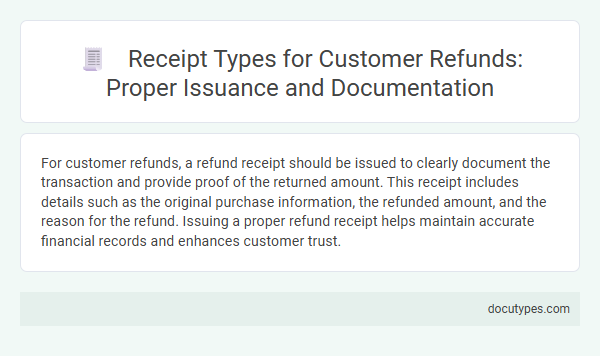For customer refunds, a refund receipt should be issued to clearly document the transaction and provide proof of the returned amount. This receipt includes details such as the original purchase information, the refunded amount, and the reason for the refund. Issuing a proper refund receipt helps maintain accurate financial records and enhances customer trust.
Introduction to Receipt Types for Customer Refunds
Understanding the appropriate receipt type for customer refunds is essential for accurate financial records. Different refund scenarios require specific documentation to ensure clarity and compliance.
Receipts for customer refunds can vary depending on the nature of the transaction and business policies. Common types include credit memos, cash refund receipts, and store credit receipts. Choosing the right receipt helps protect your business and provides clear proof of the refund to customers.
Importance of Accurate Refund Documentation
Issuing a detailed refund receipt is essential for maintaining transparent financial records and ensuring customer trust. Accurate refund documentation helps prevent disputes by clearly outlining the refunded amount, date, and reason for the transaction. Proper receipts also support compliance with accounting standards and facilitate efficient audit processes.
Cash Refund Receipts: Key Elements
Cash refund receipts serve as critical proof of transaction reversals between a business and a customer. These receipts must clearly document the refund process to maintain accurate financial records and customer trust.
- Transaction Date - Specifies the exact date when the refund was processed to ensure chronological accuracy.
- Refund Amount - Clearly indicates the amount returned to the customer, matching the original purchase price.
- Payment Method - Details the cash refund to confirm the mode of reimbursement used for the customer's benefit.
Issuing detailed cash refund receipts helps businesses comply with accounting standards and enhances customer satisfaction by providing transparent documentation.
Credit Card Refund Receipts: Best Practices
Credit card refund receipts serve as a critical record confirming the transaction reversal from a merchant to the customer. Issuing a detailed and clear receipt ensures transparency and helps maintain trust in your business processes.
- Include Transaction Details - The receipt should clearly list the original purchase information, refund amount, and date of refund to provide full transaction context.
- Show Payment Method - Indicate that the refund was processed via credit card, specifying the card type and partially masked card number for security.
- Provide Contact Information - Include merchant contact details on the receipt to enable the customer to address any questions or disputes conveniently.
Electronic vs. Paper Refund Receipts
Choosing the right type of receipt for customer refunds depends on your business needs and customer preferences. Understanding the differences between electronic and paper refund receipts can improve transaction accuracy and customer satisfaction.
- Electronic Refund Receipts - These digital receipts are sent via email or SMS, providing quick access and easy record-keeping for both businesses and customers.
- Paper Refund Receipts - Traditional printed receipts offer a tangible proof of refund, useful for customers who prefer physical documentation or lack digital access.
- Compliance and Security - Both receipt types must meet legal requirements and ensure data protection, but electronic receipts often include enhanced tracking and reduced risk of loss.
Store Credit and Gift Voucher Refund Receipts
| Refund Type | Receipt Description | Key Details Included | Purpose |
|---|---|---|---|
| Store Credit Refund Receipt | Official document issued when a refund is credited back to the customer's store account balance. | Original purchase details, refunded amount, store credit balance, expiration date (if applicable), refund date. | Confirms the value added to the customer's account for future purchases, ensuring accurate accounting and customer reference. |
| Gift Voucher Refund Receipt | Receipt provided when a refund is given in the form of a gift voucher applicable in-store or online. | Voucher code, redeemed amount, original transaction information, voucher validity period, refund date. | Validates issuance of a gift voucher refund and enables redemption tracking for both customer and store records. |
For customer refunds involving store credit or gift vouchers, your receipt should clearly represent the refund type, value, and terms, acting as proof of the transaction and supporting smooth future use.
Partial vs. Full Refund Receipt Documentation
When processing customer refunds, it is crucial to issue a receipt that clearly specifies whether the refund is partial or full. This documentation ensures transparency and maintains accurate financial records for both the business and the customer.
Partial refund receipts should detail the refunded amount while indicating the original purchase total to avoid confusion. Full refund receipts must clearly state that the entire purchase amount has been returned, confirming the transaction's completion.
Required Information on Refund Receipts
Refund receipts must clearly state the transaction details to ensure transparency for both the business and the customer. Essential information includes the date of the refund, the amount returned, and the original purchase details.
They should also include the method of refund, whether by cash, credit card, or store credit, to accurately document the transaction. Including the reason for the refund helps maintain clear communication and supports future record-keeping.
Common Errors in Refund Receipt Issuance
When issuing receipts for customer refunds, businesses should provide a clear refund receipt that includes transaction details, refund amount, and the original purchase reference. Common errors in refund receipt issuance include omitting the refund reason, failing to reference the original sale, or not specifying the refunded payment method. Proper documentation ensures transparency, reduces disputes, and maintains accurate financial records.
What Type of Receipt Should Be Issued for Customer Refunds? Infographic

